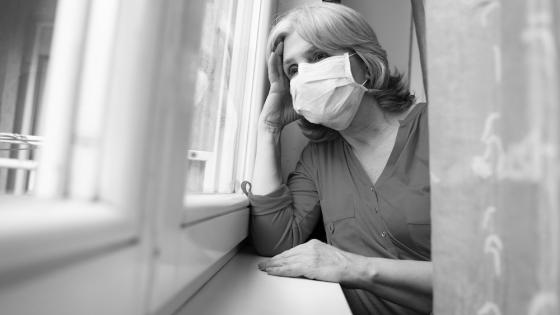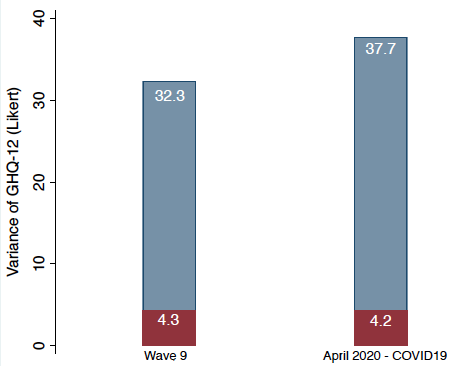The COVID-19 pandemic has highlighted existing socioeconomic inequalities in health and appears to have amplified the gradients in poor health by age, sex, ethnicity, income and wealth, education and housing in the UK. For example, evidence from the Office for National Statistics (2020) has revealed a stark social gradient in the mortality rates associated with COVID-19 and substantial socio-geographic variation in death rates across local authorities in England and Wales. The economic and policy response to COVID-19 has created specific gradients in both exposure to the disease itself and in exposure to the economic impact of the lockdown (Janke et al. 2020). These new or amplified facets of the socioeconomic gradient include, for example, those working in essential occupations (for example, in health and social care and other public services), financial and employment hardship, the presence of children in households and living in multigenerational households or as lone parents. Moreover, other facets include the influence of housing and neighbourhood environment on people’s ability to self-isolate.
Lockdown, social distancing, self-isolation, the economic impact of shut-down of parts of the economy and the focusing of resources within the health and social care systems on coping with the pandemic may all have had an indirect impact on psychological distress and the mental health of the population (Tubadji et al. 2020). Given the characteristics of the policy and institutional responses outlined above, the burden of this psychological distress may have been unequally distributed within the population. To analyse the impact of the UK response to the pandemic in terms of health equity, in Davillas and Jones (2020) we first examine inequality in psychological distress and then decompose this into the share of total inequality in psychological distress that is attributable to observed individual circumstances (e.g. Roemer and Trannoy, 2016). This share is known as Inequality of Opportunity (IOp).
To do this, we use the UK Household Longitudinal Study (UKHLS), which launched a COVID-19 survey to examine the impact of the coronavirus pandemic. During April 2020, selected participants from the UKHLS were approached to complete a short survey that focuses on the impact of the COVID-19 pandemic. We linked this to previous UKHLS waves (Institute for Social and Economic Research 2020). We use these data to measure inequality in mental health, as measured by the General Health Questionnaire (GHQ) which captures 12 indicators of psychological distress (Goldberg et al. 1997). This allows a comparison of inequalities in the distribution of GHQ before and at the peak of the first phase of the pandemic, when the fieldwork was completed on 30 April 2020, for a sample of 7,789 respondents.
The 12 dimensions of GHQ span concentration, loss of sleep, playing a useful role, ability to make decisions, coping under strain, overcoming difficulties, enjoying activities, facing problems, feeling depressed or unhappy, confidence, feeling worthless, and general happiness. Responses to the twelve dimensions are answered on a four-category scale (‘not at all’, ‘no more than usual’, ‘rather more than usual’ and ‘much more than usual’). For each of the GHQ dimensions, the two categories indicating the most depressed states are coded as one and the remaining two categories, that reflect better mental health, are coded as zero (the Caseness scoring). We use a single continuous Likert index that combines all twelve dimensions (GHQ-12) and also use a combined GHQ-12 index that is based on the Caseness scoring as an additional outcome (e.g. Maheswaran et al. 2015).
Key findings
The findings show a substantial and systematic worsening of the levels of GHQ post-COVID. This applies to nearly all of the individual elements of GHQ and to overall GHQ scores. For example, the prevalence of psychological distress based on the GHQ-12 Caseness scoring, increases from 18.3% to 28.3%. In addition, as shown by the height of the bars in Figure 1, there is a statistically significant increase in total inequality in the Likert GHQ-12 score between Wave 9 and April 2020.
However, we find lower levels of IOp in April 2020, meaning that the proportion of total inequality attributed to observed circumstances has not increased with COVID-19. Figure 1 shows that the share of inequality explained by the full set of circumstances (which we detail below) has decreased and the absolute level of explained inequality has remained stable (see the red bars).
Figure 1 Total and explained variance of psychological distress (GHQ-12 Likert score) before and during the pandemic
Individual circumstances are measured using data from before the onset of the pandemic. The choice of these variables embodies ethical judgements, defining sources of mental health inequality that are regarded as unfair. To provide additional insights into the possible impact of the pandemic, we broaden the list of circumstances beyond those that have typically been used in this literature to capture factors that are specific to the policy debate concerning the adverse consequences of COVID-19 for social inequality. These include working in industries that are more relevant for or affected by the pandemic, individuals’ employment status the presence of children in households and living in multigenerational households or as lone parents, and housing tenure. Moreover, the influence of housing conditions on people’s ability to self-isolate the neighbourhood environment and any pre-existing financial strain problems are also factors we considered.
A decomposition analysis of the explained variation allows us to explore the contribution of these specific circumstances. This is illustrated in Figure 2. At Wave 9 the largest contributors to IOp were financial strain, employment status and housing conditions. In contrast, during the peak of the pandemic (April 2020), these factors decline in their shares and age and gender account for a larger share. This is driven by greater psychological distress reported by younger men and, in particular, younger women. The contribution of working in those industries hit hardest by the responses to COVID-19 plays a small role at Wave 9 (0.74%), but more than triples its share in April 2020 (3.28%). Household composition and parental occupation have also increased their shares of the explained variance during the pandemic.
Figure 2 Decomposition of explained variance of psychological distress (GHQ-12 Likert score) before and during the pandemic
Implications of the findings
In line with the evidence on physical health, our results show a substantial worsening of the overall levels of GHQ during the peak (of the first wave) of the pandemic. This applies to nearly all of the individual elements of GHQ-12 and to overall GHQ-12 scores. In addition, there is a statistically significant increase in total inequality in the Likert GHQ-12 score between Wave 9 and April 2020. Nevertheless, inequality of opportunity – the share of total inequality that is explained by observed circumstances – has not increased. We find lower relative levels of IOp in April 2020, as the proportion of total inequality attributed to observed circumstances has not increased with COVID-19. This suggests that, with respect to the immediate impact of the pandemic on psychological distress, the greater inequality that is evident is more broadly diffused across the population than it was before the pandemic. In addition, there has been a shift in the balance of the circumstances that are associated with psychological distress, primarily due to the worsening of mental wellbeing among young adults. Greater unexplained variation may prove challenging for policy makers and it will be interesting to see whether this finding persists in future waves of the UKHLS COVID-19 survey. Greater unexplained variation may prove challenging for policy makers and it will be interesting to see whether this finding persists in future waves of the UKHLS COVID-19 survey.
Authors’ note: Understanding Society is an initiative funded by the Economic and Social Research Council and various Government Departments, with scientific leadership by the Institute for Social and Economic Research, University of Essex, and survey delivery by NatCen Social Research and Kantar Public. The research data are distributed by the UK Data Service. Andrew Jones acknowledges funding from the Leverhulme Trust Major Research Fellowship (MRF-2016-004). The funders, data creators and UK Data Service have no responsibility for the contents of this column.
References
Davillas, A and A M Jones (2020), “The COVID-19 Pandemic and its Impact on Inequality of Opportunity in Psychological Distress in the UK”, 31 May.
Goldberg, D P, R Gater, N Sartorius, T B Ustun, M Piccinelli, O Gureje and C Rutter C (1997), “The validity of two versions of the GHQ in the WHO study of mental illness in general health care” Psychological Medicine 27: 191-197.
Institute for Social and Economic Research (2020), “Understanding Society COVID-19 User Guide, Version 1.0”, University of Essex.
Janke, K, K Lee, C Propper, K Shields and M A Shields (2020), “The impact of COVID-19 on chronic health in the UK”, VoxEU.org, 13 April.
Maheswaran, H, E Kupek and S Petrou (2015), “Self-reported health and socio-economic inequalities in England, 1996–2009: repeated national cross-sectional study”, Social Science & Medicine 136-137, 135-146.
Office for National Statistics (2020), “Deaths involving COVID-19 by local area and socioeconomic deprivation: deaths occurring between 1 March and 17 April 2020”, ONS Statistical Bulletin.
Roemer, J E and A Trannoy (2016), “Equality of opportunity: theory and measurement”, Journal of Economic Literature 54: 1288-1332.
Tubadji, A, D Webber and F Boy (2020), “COVID-19: Narrative economics, public policy and mental health”, VoxEU.org, 10 June.





